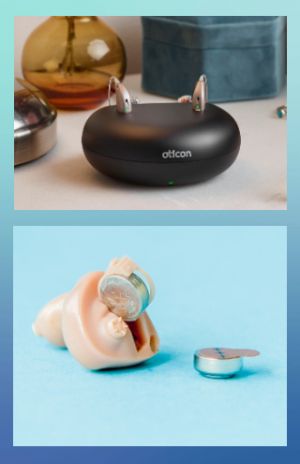|
www.HealthyHearing.com |
Hearing aids: Reviews and comparisons
By Mandy Mroz, AuD, Former President, Healthy Hearing Last updated on: October 3rd, 2023 Comparing hearing aids can help you decide which features and styles will work best for your hearing loss, budget, and lifestyle. Find out what to look for and how your hearing care professional can help. Looking for reviews and comparisons of hearing aids? 
is the best way to compare them. We're here to let you in on a little secret: While there are many different brands and types and styles of hearing aids, they're all pretty similar to each other. New models are released every year, so the features and prices are frequently changing. It's not until you get them in your ears—and have them programmed to address your specific hearing loss—can you really do a thorough comparison of what will work best for you. Everyone's ears are unique, and comparing brands and online will only go so far. This is the case for OTC hearing aids, too. Your hearing care provider plays a big role in hearing aid satisfactionIn reality, satisfaction with hearing aids is related more to the quality of your healthcare provider and not reviews of specific devices. That's because buying hearing aids isn't a one-time experience: You'll need follow-up appointments for fine-tuning your hearing aids, as well as regular repairs and cleaning of your devices. Why more than one appointment? After getting a new pair of hearing aids, you will experience sound in a variety of different settings over the next few days and weeks. You may discover that your hearing aid could use more customization for certain environments, such as music listening, which your provider can set up for you. So, look for a professional in your area who will listen carefully to your needs, preferences and previous experience so that they can help you find the best hearing solution for you. More: How to choose an audiologist or hearing instrument specialist Ask your hearing health professional for a demonstration of a couple of different brands or models. If you don't have a friend that can provide a personal recommendation, online consumer reviews can help you compare the clinics in your area. Comparing hearing aids: Shopping tipsHow hearing aids fit and sound in your ears are the two key elements to customer satisfaction. Most hearing care specialists have what are known as "demonstration" hearing aids that you can try out to get a feel for different types of aids. The devices will not be custom-fit for your ear canal, but they can be programmed for your hearing loss. It will usually only takes a few minutes for the hearing care professional to hook the hearing aids to the computer and program them for you to try. They may even do this before you arrive for your hearing aid consultation appointment. If it’s your first pair of hearing aids, it may be difficult to figure out how to distinguish between the options. Everything will sound louder and you’ll be hearing things that you haven’t heard in awhile. It can be helpful to plan a strategy for evaluating each pair. Consider the following list of ways to compare hearing aids and pick a couple of ideas to use for each set of hearing aids that you try. Be sure to take a few notes as you discover preferences. Listen to the sound of your own voiceWhen you try a pair of hearing aids, your voice will sound louder than you expect. There is always an adjustment period for new hearing aid wearers to grow accustomed to hearing their own voices. You can use this to your advantage as a comparator if you speak aloud the same sentence or paragraph for each pair of hearing aids. Recite a poem you know or read the same paragraph from a magazine for each pair of hearing aids that you wear. Are there differences in the way you perceive your own voice? Listen to the hearing aid in different program settings and environmentsMost hearing aids have programs for listening in quiet and listening in noise. Find out how to change between these programs with each set of hearing aids you wear. For listening in a quiet setting, you can just talk with the hearing care professional. For listening in a noisy setting, you will need to find a noisier place. Try going to the waiting room to talk with the receptionist or a loved one. The clinician may also have some sound samples that she can use to simulate a noisy situation, like a restaurant or a party. You may even want to walk outside and see if you can tell a difference when features like wind noise are turned on or off. Try it with your phone
decide which kind of hearing aids and battery styles work best for you. If you use your smartphone every day, try it out during your in-office trial. You don’t have to call anyone; you can just call in to your voicemail or call for the local time and weather. Determine how you need to position the phone to hear the signal through the hearing aid. Ask your hearing care professional about options for phone connectivity or snartphone apps that may exist with your model. These days, smartphones must be hearing-aid compatible. Also try a landline telephone, if there is one available to you to try. If there’s a telecoil in the demonstration hearing aids, see how that sounds with the landline phone. Consider the battery choices and what works best for youHearing aids come with rechargeable batteries or disposable "button" batteries. Rechargeable hearing aids need to be docked each night, but it's a simple process. As long as you have electricity, you can recharge your hearing aids. Portable chargers are also available for travel. For the latter, there are four common disposable battery sizes for hearing aids and they’re all relatively small. A larger hearing aid can accommodate a larger battery that usually needs to be changed less often. Each pair of hearing aids might have a slightly different design to the battery door. Getting a jump-start on learning how to change or dock the battery will help you make an informed choice in hearing aid size and style. Ask about compatible or recommended accessoriesHearing aids are a big investment in your quality of life. The best hearing aids typically have four design elements: a sleek design, Bluetooth compatibility, a telecoil for connecting to public hearing loops and rechargeable batteries. But there are also additional accessories you may want to purchase to keep them operating well for years to come, like a system to dry them out overnight or a set of filters that protect the microphone from excess earwax. Today’s hearing aids are often capable of wirelessly connecting to other audio devices, like music players, televisions and mobile phones. You might also consider assistive devices that can go beyond what the hearing aid does, like a system for flashing the lights when the doorbell rings or a bed shaker to wake you in the morning. Finding a hearing care provider matters mostTo find a hearing care provider near you, our directory of hearing clinics contains consumer reviews that are submitted by real patients via mail, online, or phone survey. All reviews are verified to assure quality and validity. Mandy Mroz, AuD, Former President, Healthy Hearing
You are reading about: Related topics
More information about hearing loss, hearing aid brands, assistive devices and tinnitus. Featured clinics near me
Earzlink Hearing Care - Reynoldsburg Find a clinicWe have more hearing clinic reviews than any other site! Related contentThe Healthy Hearing Report |
|
www.HealthyHearing.com |
Hearing aids: Reviews and comparisons
By Mandy Mroz, AuD, Former President, Healthy Hearing Last updated on: October 3rd, 2023 Comparing hearing aids can help you decide which features and styles will work best for your hearing loss, budget, and lifestyle. Find out what to look for and how your hearing care professional can help. |



 Dr. Mandy Mroz earned her doctorate in audiology from the University of Florida. Mandy’s career is guided by her dedication to serving people with hearing loss and her past experience in hearing research, training and management.
Dr. Mandy Mroz earned her doctorate in audiology from the University of Florida. Mandy’s career is guided by her dedication to serving people with hearing loss and her past experience in hearing research, training and management.